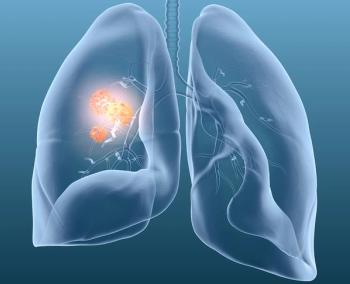
Higher Risk of Recurrence, Worse Survival Related to Delayed Surgery in Veterans With Stage I NSCLC
Veterans diagnosed with stage I non–small cell lung cancer who have experienced delays in their surgical treatment over the past 12 weeks are at a higher risk of negative disease outcomes compared with those receiving surgery immediately after diagnosis.
Veterans with stage I non–small cell lung cancer (NSCLC) who have delayed surgical procedures for more than 12 weeks are at a higher risk of recurrence and worse survival versus immediate surgical treatment, according to a study published in JAMA Network Open.
The mean (standard deviation [SD]) of time to surgical treatment (TTS) was 70.1 (38.6) days. Investigators found recurrence in 42.0% of patients with the median follow-up of 6.15 years. For each week of delayed surgery beyond 12 weeks, recurrence increased by 0.4% (HR, 1.004; 95% CI, 1.001-1.006; P = .002). Veterans who had surgery within 12 weeks of diagnosis had better overall survival than those who delayed (HR, 1.132; 95% CI, 1.064-1.204; P < .001).
“This cohort study examined the association of delayed surgical treatment with oncologic outcomes in patients in the VHA [Veterans Health Administration] with clinical stage I lung cancer. Using a more robust and precise method for quantifying surgical delay…our study found that patients who waited more than 12 weeks for resection had an increased risk of recurrence,” wrote investigators of the study who were led by Brendan T. Heiden, MD.
There were 9904 veterans who met inclusion criteria, of whom 96.3% were men and 50.5% were smoking at the time of surgical treatment. There were 26.6% of patients who had a 0-day wait time between diagnosis and surgery.
In the population, 70.1% of veterans underwent a lobectomy and 53.3% had a minimally invasive incision. It was found that 52.9% of patients had adenocarcinomas and most had tumor grades greater than I, comprised of grade II (52.5%), grade III (33.0%), and grade IV (1.5%).
At 30 days, 2.1% of patients had died whereas 8.2% had been readmitted.
There was pathological upstaging in 12.3% of patients and positive surgical margins found in 3.1%. Patients who had higher odds of upstaging were younger in age (OR for every 1-year increase, 0.985; 95% CI, 0.975-0.996; P = .006), had higher tumor grade (OR, 3.145; 95% CI, 2.341-4.224; P < .001), had larger tumor size (OR, 1.734; 95% CI, 1.250-2.407; P = .03), had greater number of lymph nodes examined (OR, 1.476; 95% CI, 1.275-1.709; P = .009), or were treated with pneumonectomy vs lobectomy (OR, 3.528; 95% CI, 2.415-5.153; P < .001).
The factors that were associated with higher odds of positive surgical margins were wedge resections vs lobectomy (OR, 2.501; 95% CI, 1.866-3.352; P < .001) and larger tumor size (OR, 3.087; 95% CI, 1.651-5.771; P < .001). There was no significant association between radiologic TTS (RTTS) and upstaging or a resection of positive margins from.
The median time to recurrence was 1.24 years (interquartile range, 0.43-2.76). An increased risk of recurrence was associated with younger age (HR for every 1-year increase, 0.992; 95% CI, 0.987-0.997; P = .002), higher Charlson Comorbidity Index score (HR for every 1 unit increase, 1.055; 95% CI, 1.037-1.073; P < .001), segmentectomy vs lobectomy (HR, 1.352; 95% CI, 1.179-1.551; P < .001) or wedge resection vs lobectomy (HR, 1.282; 95% CI, 1.179-1.394; P< .001), higher tumor grade (HR, 1.210; 95% CI, 1.085-1.349; P < .001), larger tumor size (HR, 1.209; 95% CI, 1.051-1.390; P = .008), lower number of lymph nodes examined (HR, 0.866; 95% CI, 0.803-0.933; P < .001), higher pathologic stage (HR 1.571; 95% CI, 1.351-1.837; P < .001), and longer RTTS.
Factors associated with surgical procedure delay longer than 12 weeks were African American race (OR vs White race, 1.267; 95% CI, 1.112-1.444; P < .001), higher area deprivation index score (OR every 1 unit increase, 1.005; 95% CI, 1.002-1.007; P = .002), lower hospital case load (OR for every 1 unit increase, 0.998; 95% CI, 0.998- 0.999; P = .001), year of diagnosis (OR for each additional year, 0.900; 95% CI, 0.884-0.915; P < .001), and performance of a preoperative mediastinoscopy or endobronchial ultrasonography (OR, 1.385; 95% CI, 1.226-1.564; P < .001).
Investigators found that smoking status, Charlson-Deyo Comorbidity Index, and frailty were not associated with longer RTTS.
“These findings suggest that veterans with clinical stage I lung cancer who wait more than 12 weeks for resection may have an increased risk of recurrence and worse survival rates. Efforts to minimize delays in surgical procedures for lung cancer are essential to decrease the risk of disease recurrence and the associated worse prognosis,” concluded study investigators.
Reference
Heiden BT, Eaton DB Jr, Engelhardt KE, et al. Analysis of delayed surgical treatment and oncologic outcomes in clinical stage I non-small cell lung cancer. JAMA Netw Open. 2021;4(5):e2111613. doi:10.1001/jamanetworkopen.2021.11613
Newsletter
Stay up to date on recent advances in the multidisciplinary approach to cancer.

















































































